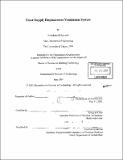| dc.contributor.advisor | Qingyan Chen. | en_US |
| dc.contributor.author | Kobayashi, Nobukazu, 1967- | en_US |
| dc.contributor.other | Massachusetts Institute of Technology. Dept. of Architecture. | en_US |
| dc.date.accessioned | 2005-08-23T22:21:42Z | |
| dc.date.available | 2005-08-23T22:21:42Z | |
| dc.date.copyright | 2001 | en_US |
| dc.date.issued | 2001 | en_US |
| dc.identifier.uri | http://hdl.handle.net/1721.1/8688 | |
| dc.description | Thesis (S.M.)--Massachusetts Institute of Technology, Dept. of Architecture, 2001. | en_US |
| dc.description | Includes bibliographical references (p. 104-106). | en_US |
| dc.description.abstract | Research on indoor environments has received more attention recently because reports of symptoms and other health complaints related to indoor environments have been increasing. Heating, ventilating, and air-conditioning (HVAC) systems are used to control the indoor environment. Therefore, it is necessary to provide a good ventilation system that can provide good indoor environment. To improve indoor air quality, displacement ventilation systems can work well. The system provides fresh air directly to the occupied zone. However, the existing floor-supply displacement ventilation systems have some problems. Hence, the objective of this research was to improve the disadvantages of the current system, and to develop a new design for the floor-supply displacement ventilation system with floor diffusers. The research used numerical simulations through computational-fluid-dynamics (CFD). The experiment was carried out in a full -scale environmental chamber to obtain a reliable data on the floor-supply ventilation system. With the detailed data, the CFD program used in this research was validated. By using the validated program, we conducted numerical simulations of several different cases of the floor-supply system to evaluate the design and the performance of the system. The impacts of several parameters, such as the air change rate, number of diffusers, furniture arrangement, and cooling loads, on the indoor environment were investigated based on the thermal comfort level and indoor air quality. From the results, the parameters were ranked in the order of their impact. This result can be used for more specific case studies of each building design. | en_US |
| dc.description.statementofresponsibility | by Nobukazu Kobayashi. | en_US |
| dc.format.extent | 174 p. | en_US |
| dc.format.extent | 13097794 bytes | |
| dc.format.extent | 13097552 bytes | |
| dc.format.mimetype | application/pdf | |
| dc.format.mimetype | application/pdf | |
| dc.language.iso | eng | en_US |
| dc.publisher | Massachusetts Institute of Technology | en_US |
| dc.rights | M.I.T. theses are protected by copyright. They may be viewed from this source for any purpose, but reproduction or distribution in any format is prohibited without written permission. See provided URL for inquiries about permission. | en_US |
| dc.rights.uri | http://dspace.mit.edu/handle/1721.1/7582 | |
| dc.subject | Architecture. | en_US |
| dc.title | Floor-supply displacement ventilation system | en_US |
| dc.type | Thesis | en_US |
| dc.description.degree | S.M. | en_US |
| dc.contributor.department | Massachusetts Institute of Technology. Department of Architecture | |
| dc.identifier.oclc | 49752349 | en_US |
